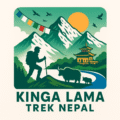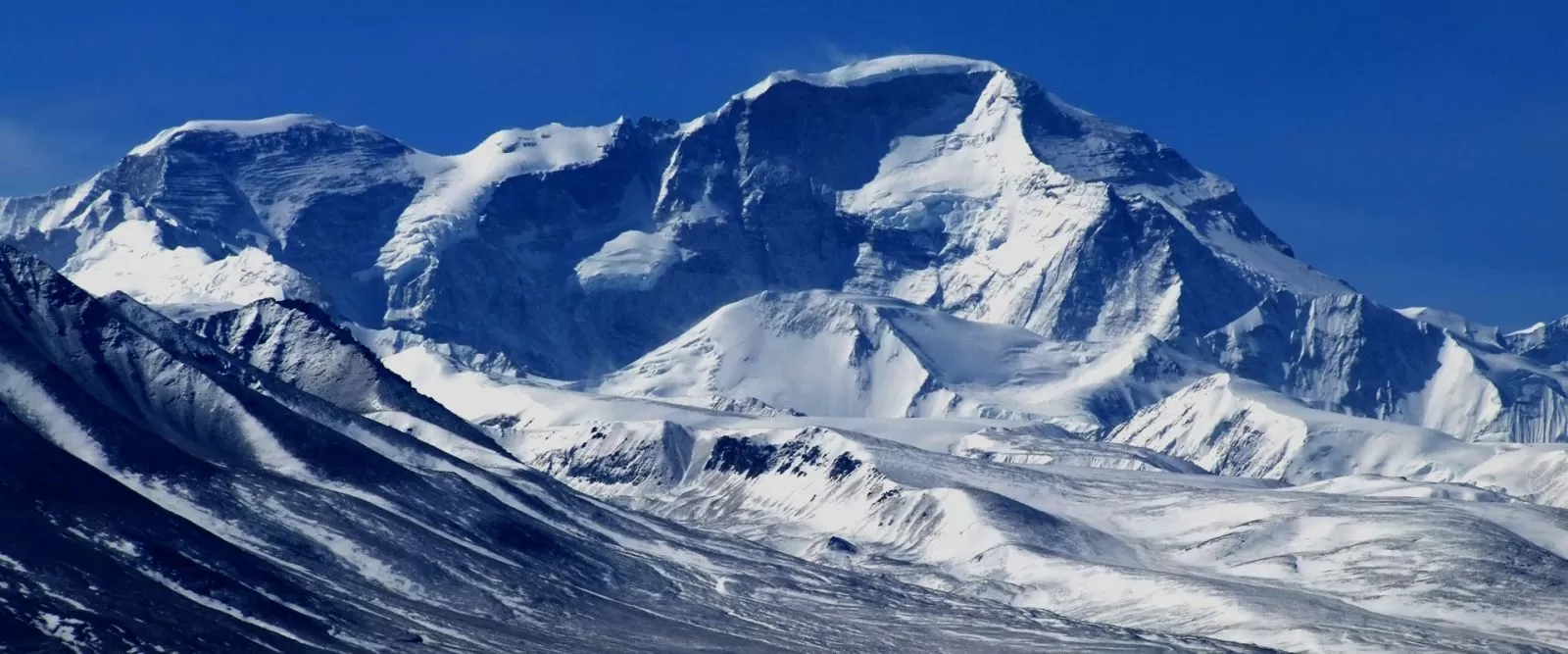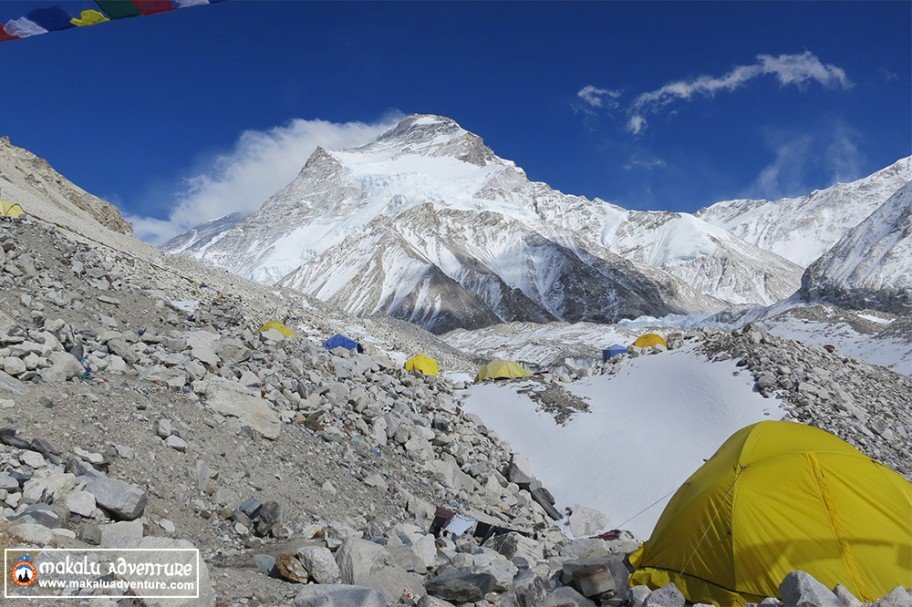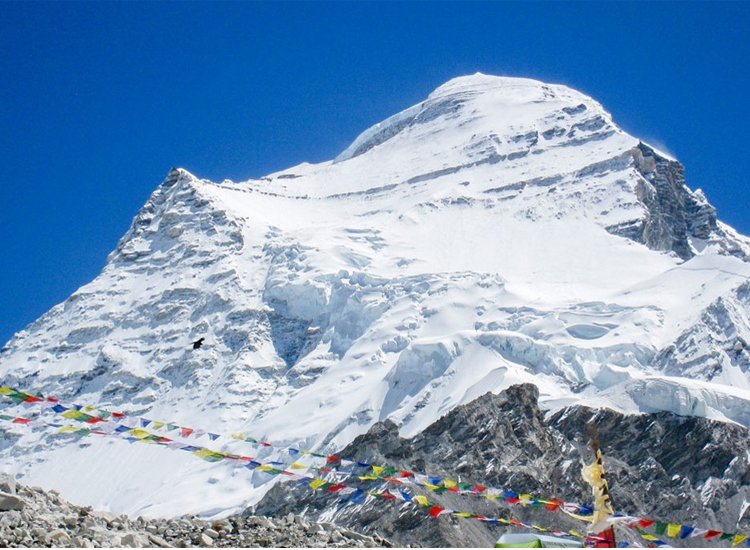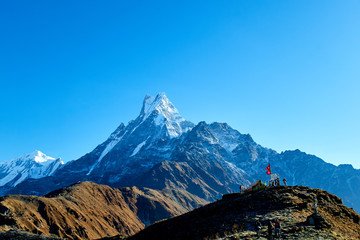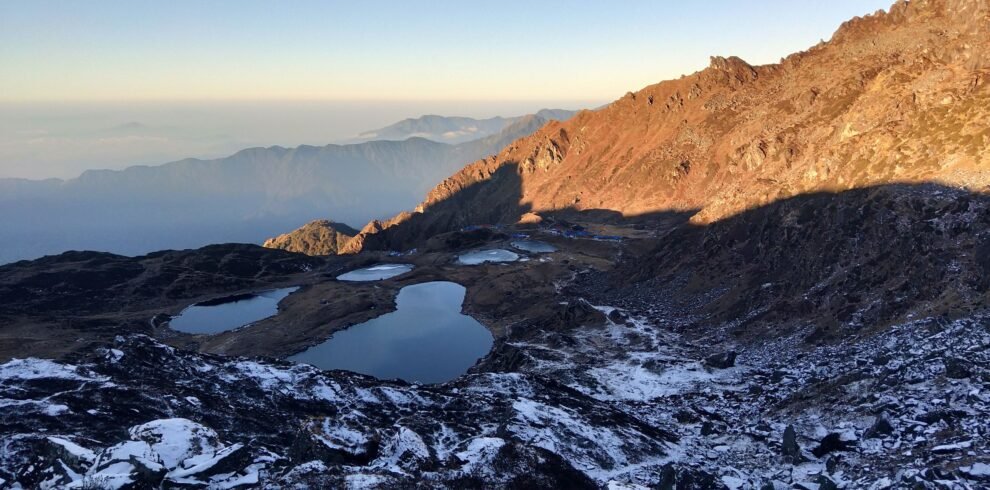Pricing is negotiable and can be discussed in USD or Euros.
The Cho Oyo Expedition was first attempted in 1952 by an expedition organised and financed by the Joint Himalayan Committee of Great Britain as preparation for an attempt on Mount Everest the following year. The expedition was led by Eric Shipton and included Edmund Hillary, Tom Bourdillon, and George Lowe. A foray by Hillary and Lowe was stopped due to technical difficulties and avalanche danger at an ice cliff above 6,650 m, and a report of Chinese troops a short distance across the border influenced Shipton to retreat from the mountain rather than continue to attempt to summit.
The mountain was first climbed on October 19, 1954, via the north-west ridge by Herbert Tichy, Joseph Jöchler, and Sherpa Pasang Dawa Lama of an Austrian expedition. Cho Oyu was the fifth eight-thousander to be climbed, after Annapurna in June 1950, Mount Everest in May 1953, Nanga Parbat in July 1953, and K2 in July 1954. Until the ascent of Mount Everest by Reinhold Messner and Peter Habeler in 1978, this was the highest peak climbed without supplemental oxygen.
Overview
Mount Cho-Oyu is the world’s 6th highest peak at (8,201m) above sea level. It lies 20 km west of Mt. Everest on the border between Tibet ( China) and Nepal. This mountain is considered the easiest among 8,000 meters high Himalayan Mountains for climbing due to non-existent of technical difficulties and objective dangers. According to legends Cho Oyu is called ‘Turquoise God’ in Tibetan language and highly regarded in Tibet. Most of the Cho Oyu climbing expeditions are undertaken from Tibet side due to a relatively comfortable climbing route. From Nepal side, it is very difficult to organize the climbing expedition.
Trip Highlights
- The summit of Cho Oyu 8201m, the sixth-highest mountain in the world, gives climbers a profound sense of accomplishment.
- Climbers at the summit can enjoy a breathtaking panorama of the Himalayan range, including well-known peaks like Everest, Lhotse, and Makalu.
- Travelers experience the rich culture, especially interacting with the Sherpa communities in the Khumbu region.
- Climbers learn important skills for climbing at high altitudes and how to get used to the thin air.
- The area around Cho Oyu lets climbers see unique animals and plants found only in the Himalayas, adding to the experience.
- Setting up camp at the base of Cho Oyu, located in a remote and scenic area, is an exciting part of the journey.
- The area around Cho Oyu lets climbers see unique animals and plants found only in the Himalayas, adding to the experience.
- Excellent preliminary peak for Everest.
- Easiest of the fourteen 8,000m peaks.
- 6th highest mountain in the world.
Itinerary
Arrival in Kathmandu (1,400m) marks the first step of your Cho Oyu expedition. Upon landing at Tribhuvan International Airport, you will be warmly welcomed by your expedition team, who will assist you with immigration and luggage. From the airport, you will transfer to your hotel in the lively Thamel area, where you can settle in and rest. This time allows you to recover from your journey and begin acclimatizing to the altitude and local environment before the expedition activities begin.
On Preparation Day in Kathmandu (1,400m), you will organize and check your gear, attend team briefings, complete necessary paperwork, and rest to get ready for the expedition ahead.
On this day, you will take a flight from Kathmandu to Gongkar Airport near Lhasa, which sits at an altitude of 3,650 meters. The flight offers stunning views of the Himalayas and takes about one hour. Upon arrival, you will clear customs and immigration before transferring to your hotel in Lhasa. This day allows you to start acclimatizing to the higher altitude and prepare for the next phase of the Cho Oyu expedition.
On the sightseeing day in Lhasa (3,650m), you will explore some of Tibet’s most famous cultural and spiritual sites. Highlights often include visits to the iconic Potala Palace, Jokhang Temple, and Barkhor Street. This day helps you acclimate to the altitude while experiencing the rich history, architecture, and local Tibetan culture before continuing your Cho Oyu expedition.
The drive from Lhasa to Gyantse (3,950m) is a scenic journey through the Tibetan plateau, covering approximately 270 kilometers. Along the way, you'll pass stunning landscapes including rolling hills, vast grasslands, and traditional Tibetan villages. The trip usually takes around 5 to 6 hours. This drive helps you gradually acclimatize to higher altitudes while experiencing the unique culture and natural beauty of the region before reaching Gyantse, a historic town known for its ancient fortress and monasteries.
The drive from Gyantse to Shigatse (3,950m) is about 93 km and takes around 2 hours. The route offers scenic views of Tibetan farmland and traditional villages. In Shigatse, you can visit the famous Tashilhunpo Monastery, an important cultural and religious site.
The drive from Shigatse to Tingri (4,350m) is about 240–300 km and takes around 4 to 6 hours. The route passes mountain passes like Tsola Pass and Gyatso La, offering stunning views of Everest and surrounding peaks. The road is mostly paved but can be rough in places, making a 4WD vehicle recommended.
Rest day at Tingri (4,350m) is dedicated to acclimatization before ascending to higher altitudes. During this day, you’ll take it easy, hydrate well, and avoid strenuous activities to help your body adjust. Some gentle walks nearby may be done to aid acclimatization, but the focus remains on rest. Proper acclimatization here is important to prepare for the challenging climb ahead.
The drive from Tingri to the Chinese Everest Base Camp (4,800m) is about 120 km and takes 4 to 5 hours. The mostly paved route offers spectacular views of Everest, Cho Oyu, and surrounding peaks, passing Gyawula Pass (5,210m). Private vehicles are restricted near base camp, so a shuttle bus completes the final stretch. This drive provides an unforgettable close-up experience of the world’s highest mountain.
At the Chinese Everest Base Camp (4,800m), rest and acclimatization are crucial to prepare your body for higher altitudes. During this time, you’ll focus on staying hydrated, eating well, and avoiding strenuous activity. Gentle walks around the camp may help your body adjust, but the main goal is to allow your lungs and muscles to adapt to the thinner air, reducing the risk of altitude sickness before the climb begins.
The trek from Chinese Base Camp (5,200m) to Middle Camp (5,300m) is about 12 km and takes 4–5 hours. It’s a gradual climb over rocky and icy terrain with stunning views of Everest and Cho Oyu. Middle Camp is used for acclimatization before moving higher on the mountain.
The trek from Middle Camp (5,300m) to Advanced Base Camp (ABC) at 5,700 meters involves a steeper and more challenging climb over rocky and icy terrain. This short but demanding trek usually takes 3 to 4 hours. Along the way, you’ll navigate moraine slopes and glacial paths, gaining important altitude to prepare your body for the higher climbs ahead. ABC serves as the main staging area for summit attempts and further acclimatization.
The final climbing period to summit Cho Oyu, which stands at 8,201 meters, usually lasts between 13 to 39 days depending on weather, acclimatization, and team progress. During this phase, climbers move gradually through a series of high camps above the Advanced Base Camp, carefully acclimatizing and preparing for the summit push. The ascent involves navigating glaciers, icefalls, and steep snow slopes. Weather windows are critical, and summit attempts are made when conditions are safest. Reaching the summit of Cho Oyu is a major achievement, offering breathtaking views and a rewarding experience as the sixth highest peak in the world.
On Day 40, you trek back from Advanced Base Camp to Middle Camp, descending through rocky and glacial terrain. After resting briefly at Middle Camp, you continue the journey by driving back to Tingri (4,348m). This drive offers scenic views of the Tibetan plateau and nearby Himalayan peaks, marking a transition from high-altitude climbing back to a lower elevation for recovery.
On Day 41, you will drive from Tingri back to Shigatse (Xigatse), covering about 240 kilometers. The journey takes around 4 to 6 hours along the scenic Friendship Highway, passing through Tibetan villages, vast plateaus, and mountain passes. This drive allows time to relax and enjoy the unique landscapes and culture of the Tibetan region after your high-altitude trek.
On Day 42, you will take an early morning drive from Shigatse to Lhasa, covering approximately 270 kilometers. The journey usually takes 5 to 6 hours along the Friendship Highway, offering beautiful views of Tibetan landscapes, traditional villages, and rolling hills. Starting early helps you avoid traffic and gives you more time to rest or explore Lhasa upon arrival.
On Day 43, you will fly from Lhasa back to Kathmandu. The flight takes about one hour and offers stunning views of the Himalayas, including peaks like Everest and Cho Oyu. Upon arrival at Tribhuvan International Airport, you will clear customs and transfer to your hotel in Kathmandu to rest and recover after your journey.
Spending a free day in Kathmandu, the heart of Nepal, is like diving into a living museum of history, spirituality, and culture. Whether it's your 1st or 44th free day here, the city never ceases to offer something new, vibrant, and inspiring.
The 45th day marks the end of a journey, a chapter closing not with loud celebration but with quiet reflection. “Departure Day at Home” is not just about leaving a place — it's about the emotions, the memories, and the subtle goodbyes that linger in the air.
After completing your trek, you'll drive back to Kathmandu through scenic countryside roads. When you're ready for your international flight, a representative from Kinga Lama Trek Nepal will transfer you to Tribhuvan International Airport (TIA) for your final departure.
Cost
Cost Includes
- All arrival and departure transfer services to and from the international airports.
- 3-night request star hotel accommodation in Kathmandu as per itinerary.
- Truck for expedition equipment from Kathmandu-Kerung-Kathmandu.
- Land Transportation from KTM-KERUNG-KTM for Climbing members and Staff.
- Chinese custom clearances at the border.
- Chinese Government Royalty for Cho-Oyu Expedition for the group and climbing Sherpa guide.
- Chinese visa for the climbing period, both Base Camp staff, Sherpa and group.
- Climbing Sherpa guide and leaders will be included.
- Selected English speaking Chinese liaison officer and interpreter.
- All camping equipment in Base camp and Advance Base Camp.
- Full Board hotel in route in Tibet: Lhasa, Tingri (B/L/D).
- Food during expedition period for expedition members and staff..
- Tibet Visa and Travel Permit for expedition cre.
- Expedition Permit to climbing Cho Oyu along northwest ridge route.
- Permanent kitchen facilities at advance base camp.
- All staff during the Expedition period with an experienced guide (Base Camp Manager) as per group size.
- Surface transportation will be available as per itinerary.
- Cargo clearance & duties assistance service free.
- Daily wages, equipment allowance & insurance for expedition staff.
- Gamow Bag will be available for expedition group.
- Solar panel for light and batteries charger will be available for expedition members.
- Quality personal tent at base camp and advance base camp.
- Permanent kitchen and dining facilities at advance base camp.
- All necessary climbing hardware and ropes.
- Preferable meals at BC, Ad.BC, higher camps, hot drinks, and beverages, freeze-dried food during an expedition.
- 24 hours hot drinks and beverage during the expedition.
- Quality high altitude freeze-dried food for Sherpa and staff.
- 2 Oxygen Bottles with mask and regulators (if requested by client).
- We provide Sherpa's tents, food for climbing, and insurance.
- Icefalls charges, all high-quality tent for higher camps 1, 2, 3.
- EPI gas and burners for cooking food above base camp.
- Per person 50kg baggage allowance during trekking-up and down carrying by Yak.
- The truck will be provided at Kerung border - Chinese base camp and return Kerung for loads.
- Yaks carry the loads from Chinese base camp to middle camp to advance base camp and return.
- Required experienced, trained and Government Licensed climbing guide(s) during climbing period per person as per requirements.
- First Aid medical kits for the group and the staff.
- Satellite phone carrying by guide for communication and available for members with the cost of US$ 3 per minute call.
- Appropriate food for high altitude and all climbing crew at base camp and above as required.
- Emergency oxygen and mask regulator.
- All necessary paper works, office Service charge, and Government Taxes levied in Nepal.
- Complete pre-departure information, flight ticket reconfirmation, and visa extension procedure services (if necessary).
- Farewell dinner in a typical Nepali restaurant with domestic culture show in Kathmandu before departure.
Cost Excludes
- Airfare of international flights.
- Nepal entry and re-entry visa fee (Visa issuance on arrival in Kathmandu).
- Lunch and Dinner during your stay in Kathmandu.
- Any packed food/snacks, aerated drinks, energy drinks, mineral water, alcohol, cigarettes, chocolates, nutria-bars during the trekking.
- Items of personal nature, Laundry Expenses, Tips.
- Any extra expenses arising out of various/unforeseen situations like natural calamities, landslides.
- Political disturbances, strikes, changes in Government regulations, etc.
- Extra transportation then displays in the itinerary program.
- Any additional staff other than specified.
- Rescue, Repatriation, Medicines, Medical Tests and Hospitalization expenses.
- Medical Insurance and emergency rescue evacuation if required.
- Travel Insurance and helicopter rescue.
- Walkie-talkies & Filming permit (if a special camera or walkies-talkies).
- Personal climbing gears.
- Expenses incurred towards usage of landlines, mobiles, walkie-talkies or satellite phone And Internet expenses.
- Clothing, Packing Items or Bags, Personal Medical Kit, Camera/Video Fees or Trekking Gears.
- Nepal custom duty for import of expedition goods.
- Tips or gifts for base camp and high altitude trekking and climbing staff.
- Summit bonus for climbing Sherpa guide, minimum US $ 1500.00 per climbing Sherpa guide.
- Any extra services or products or offers or activities which are not mentioned in the itinerary.
- Any other item not included in the “inclusion” section.
FAQs
Yes,
While it is possible to climb Cho Oyu independently, it is highly recommended to have the support of experienced climbers or professional guides. They can provide crucial guidance, assistance, and ensure your safety during the expedition.
Yes, you need to obtain a climbing permit from the Tibet Mountaineering Association (TMA) if climbing from the Tibetan side or from the Nepal Mountaineering Association (NMA) if climbing from the Nepalese side. The permit can be obtained through a registered trekking agency or a professional mountaineering organization.
As of now, thousands of climbers have successfully summited Cho Oyu since the first ascent in 1954. It is one of the more popular 8,000-meter peaks and sees a significant number of climbers each year.
The best time to climb Cho Oyu Expedition is in the Fall, August-October. How many climbers are on this expedition? Generally, our maximum for this climb is 10 climbers plus guides and Sherpa.
